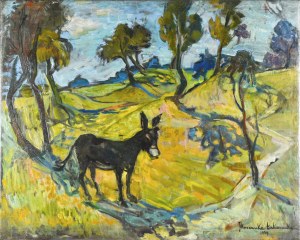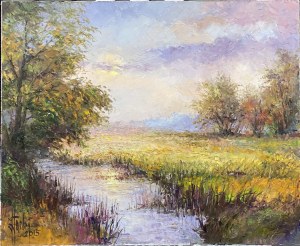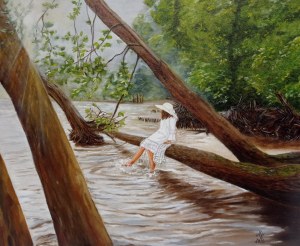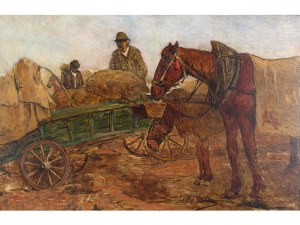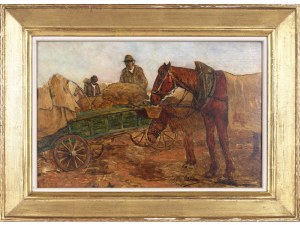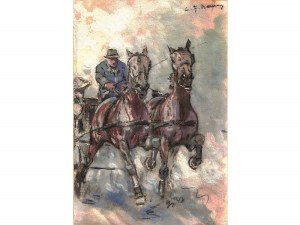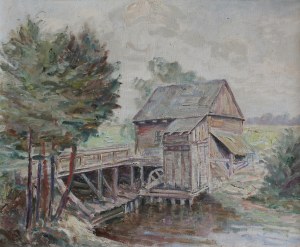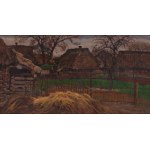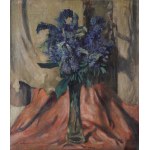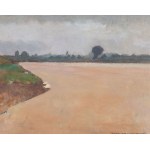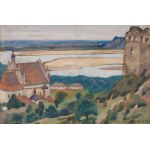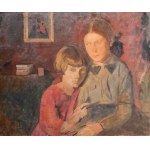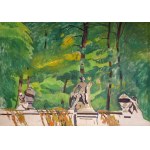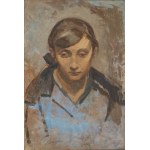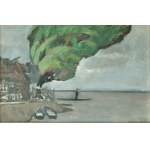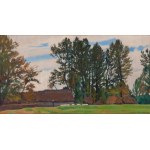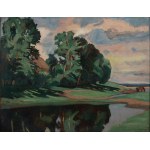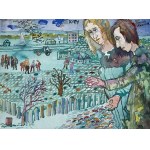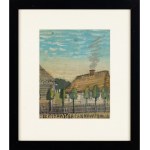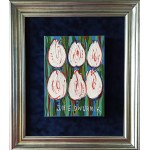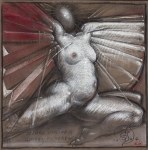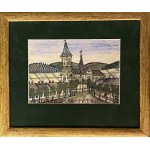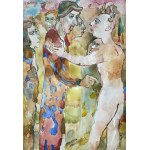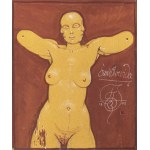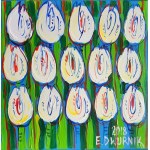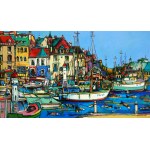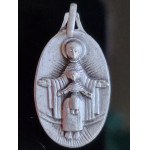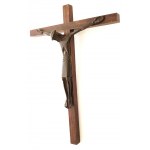oil/board, 29.5 x 62, 5 cm
signed l.d.: ST.CZAJKOWSKI
On the reverse, description by Anna Czajkowska: Stanislaw Czajkowski | "Świątki nad Wisłą" |.
1919 | A sketch surviving from warfare for the painting located in the National Museum below her dedication from March 1958 to Witold Małcużyński
In 1930, on the occasion of a solo exhibition of Stanislaw Czajkowski organized in Warsaw's Zachęta Gallery, Artur Schroeder described his artistic career: "Czajkowski was born in 1878 in Warsaw. After graduating from high schools there, he enrolls in the Krakow Academy under Jacek Malczewski. In 1900 he goes to Paris and works for a number of years under the direction of Professor Jen Paul Leurens. Already his first works draw attention to him, and when he returns to the country [...] and begins to exhibit in the country, he immediately enters the circle of the most prominent visual artists of the time. He is a member of "Art", his paintings are sent to exhibitions in almost all the major cities of Europe, his works hang in numerous national and foreign museums" (A. Schroeder, Stanislaw Czajkowski, "Sztuki Piękne" 1930, R VI: July-August, p. 268). The reviewer also referred to the exhibited works: "Only in this juxtaposition of dozens of canvases, very diverse, could the characteristics of the artist's talent be properly known. Tchaikovsky's deep emotionality and sentiment (without sentimentality), his sensitivity to the general mood of the landscape and his synthetic grasp of it, accentuating the original qualities inherent in this landscape and bringing them out with a modest scale of colors, as if deliberately not illuminated by full sunlight [...]" (ibid., p. 265).
What Schroeder failed to mention is that between trips abroad in the first decade of the 20th century, Tchaikovsky briefly studied under Jan Stanislavsky, who influenced him and with whom his student was compared. Stanislavsky's landscape art was firmly rooted in 19th-century symbolism. Tchaikovsky, on the other hand, was close to the gaze of a realist not devoid, however, of the sensibility of a poet. In 1923 when Tchaikovsky's works were exhibited at the Garlinski Salon, a columnist for "Tygodnik Ilustrowany" noted: "Czajkowski's paintings tell us that he feels deeply the poetry of the Polish landscape, that he pours the feeling of this poetry digested in himself with an admixture of sometimes some philosophical snot onto the canvas. So the inner motive of Czajkowski's painting is the poetry of the Polish landscape; in execution, in the choice of subject matter [...] he is a man of great taste and calm deep culture. Whoever is looking for violent effects, flashy brightness, fashionable eccentricities, should not look at his paintings, because Tchaikovsky is first and foremost a poet. He is a lyrical poet, his paintings are songs in honor of the Polish landscape he loves" (Dr. Jan Włodek, On the Art of St. Czajkowski, "Tygodnik Ilustrowany" 1923, No. 11).
The Dutch episode was also important for the formation of the landscape painter. As Irena Kossowska noted, "The paintings of 17th-century Dutch masters became a point of reference and a model of technical excellence for Tchaikovsky during his stay in the Netherlands (1914-1917). The object of the artist's fascination at that time became the changeability of the sky, the flow of clouds over the immensity of the sea, sails flapping in the wind, sea waves crashing on the shore [...]" (artist's bio at: https://culture.pl/pl/tworca/stanislaw-czajkowski).
The presented sketch for the landscape foreshadows the final painting, which is in the collection of the National Museum in Warsaw. The subtle colors of the sketch are captivating, and the synthesis of forms is thoroughly modern. The painter brilliantly captured the character of the Vistula River plein air, aptly capturing the local color and light. The depicted shrine is an accent of religious tradition in the Polish landscape.
In 1954, addressing his students, Czajkowski wrote about landscape in a truly romantic way: "Landscape is the soul of the earth, on which man is born and dies and which he, in a way, creates. This soul is as rich as the varieties of weather throughout the year and [...] throughout the day. Landscape reigns in every art: in painting, literature and music. It is difficult to imagine our painting without Chelmonski, Malczewski, Stanislawski and Falat [...]. Also, it's hard to imagine our literature without landscape descriptions, from Mickiewicz to Zeromski and Tuwim. Listening to Chopin's music, one cannot take one's mind off our landscape. [...] Painting a landscape gives you sublime, unforgettable moments of merging with nature. We have had the landscape in our eyes since we first opened them in life, and this image never leaves us again - that's why the longing for the homeland is so great when we have to look at foreign skies, foreign trees and foreign waters against our will. [...] Our landscape is beautiful and has a variety of physiognomies: Kielce, Kurpie, Masuria, Silesia, Podhale and our sea and Pomerania have different character, as well as the people of these sites differ from each other" (S. Czajkowski, O pejzażu (Letter of Stanislaw Czajkowski to his students before leaving for the open air in Sandomierz), [in:] Stanislaw Czajkowski 1878-1954. Painting, Warsaw "Zachęta", 19.12.1980 - 11.01.1081 [exhibition cat.], Warsaw 1980, p. nlb).
The above reflection by Czajkowski acquires symbolic meaning in the context of the history of the presented object. The sketch was donated by the artist's widow, Anna Czajkowska, to Witold Malcuzynski in 1958. This outstanding Polish pianist was in Paris at the outbreak of World War II. Since then he had lived in exile. It was in 1958 that he gave his first concert in Poland after the war.
As Monika Ochnio has shown, three oil paintings by Tchaikovsky showing the same shrine on the Vistula River are known. These works were made in different formats: "Świątki nad Wisłą" from 1921 (oil/canvas, 54 x 170 cm; the painting was presented at a monographic exhibition at Warsaw's Zachęta Gallery at the turn of 1980 and 1981, cat. no. 201, repr.), "Saints on the Vistula River" from 1923 (in vertical format, framed with the shrine; presented at an exhibition in the Art Salon of Cz. Garlinski in 1923; repr. on the cover of "Tygodnik Ilustrowany" 1923, no. 11), "Saints by the Water" from ca. 1921-1925 (oil/canvas, 42 x 95.5 cm, stored at the National Museum in Warsaw). There is also a watercolor "Chapel on the Vistula River" (ca. 1920, watercolor/paper, 17.4 x 23.2 cm; stored at the Central Maritime Museum in Gdansk) (compiled at: https://cyfrowe.mnw.art.pl/pl/katalog/507892).
Recently viewed
Please log in to see lots list
Favourites
Please log in to see lots list









